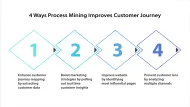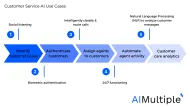Voice of Customer Best Practices in 2024
A survey including 1,000 respondents from the U.S. shows that 70% of customers prefer to shop from companies that understand their needs.1 However, ~55% don’t think the companies can achieve this goal. Understanding customer behavior can be challenging as implementing an effective voice of customer program requires a strategic approach and adherence to best practices.
This article delves into the process of implementing a truly influential voice of customer (VoC) program. We’ll share the 10 best practices to help businesses transform customer feedback into a strategic advantage that propels your company forward in today’s dynamic and customer-centric environment.
What do most companies get wrong in their voice of customer programs?
Companies often struggle to fully leverage the Voice of Customer (VoC) for various reasons. Some common mistakes and challenges businesses face in collecting customer feedback and analyzing it include the following:
- Lack of a structured VoC program: Many companies do not have a well-defined VoC program, leading to scattered and inconsistent customer data collection.
- Inability to integrate data: Companies may collect VoC data from multiple sources but fail to integrate the data effectively, resulting in disconnected insights.
- Inadequate data analysis tools and methods: Some businesses struggle to analyze and interpret the massive amount of VoC data they collect. They may lack the necessary customer data analysis tools or expertise to uncover meaningful insights from the data.
- Insufficient action plan: Companies that do not take prompt and meaningful action based on customer feedback may fail to realize the full potential of VoC insights.
- Not measuring KPIs: Some companies struggle to assess the effectiveness of their VoC programs, making it difficult to optimize and improve them over time.
10 voice of customer best practices
Source: Lucidchart
Figure 1. Example of how to turn the voice of customers into actionable insights.
1. Define clear goals
Establish the objectives of your VoC program to collect customer feedback, ensuring that they align with your overall business strategy. Set specific, measurable, achievable, relevant, and time-bound (SMART) goals to guide the program’s direction and facilitate progress evaluation.
If you don’t know where to start, here is our article on the top data sources to gather customer insights.
2. Engage stakeholders
Acquire support from key stakeholders within your organization, highlighting the significance of VoC in driving business growth and customer satisfaction. Arrange meetings or workshops to present your plans, discuss benefits, and address concerns to foster a collaborative atmosphere.
3. Opt for the right tools & methods
Assess your needs and resources before selecting the most appropriate data collection methods and tools to effectively capture and analyze customer feedback. When in doubt, pilot different methods to determine which ones yield the most actionable customer insights for your context.
You can check out our article on the essential steps in customer analytics.
4. Establish a core VoC team
Invest in training and development to equip your team with the necessary skills and knowledge to implement the VoC program. Encourage cross-functional collaboration to promote a broader understanding of customer needs and facilitate well-informed decision-making.
5. Visualize results
Establish a transparent communication strategy to disseminate the findings and insights from your VoC program to relevant stakeholders. Use data visualization, reports, or presentations to convey complex data in an easily digestible format, ensuring that insights are accessible and actionable for all involved parties.
For those interested, here is our article on the top data visualization tools.
6. Act on insights
Create an action plan to implement improvements based on the insights gained from your VoC program. Prioritize initiatives based on potential impact, resource requirements, and feasibility. Assign clear ownership and deadlines to ensure timely execution and follow-through for a better customer journey.
7. Monitor and iterate
Regularly assess the impact of implemented changes by tracking key performance indicators (KPIs) and customer feedback. Be prepared to make further adjustments and regularly monitor your VoC program to ensure it remains effective and relevant. Foster a culture of continuous improvement by celebrating successes and learning from setbacks.
8. Solicit customer input
Involve customers in your VoC program by inviting them to participate in surveys, interviews, or focus groups. Make it easy for customers to provide feedback by offering multiple channels, such as email, phone, social media, or chatbots, and express appreciation for their valuable input. This will help understand whether customer experience changes over time and ease customer relationship management.
9. Integrate VOC data
Leverage data analytics tools to combine VoC data from various sources, providing a comprehensive view of customer sentiment and needs. This holistic approach enables more accurate and insightful decision-making.
Here, you can find our benchmarking study on customer feedback analysis tools.
10. Maintain an ongoing commitment
Source: LinkedIn
Figure 2. The cycle of VoC programs
Treat your VoC program as an ongoing process rather than a one-time project. Regularly revisit objectives, methods, and goals to ensure they stay aligned with your evolving business needs and customer expectations. Maintaining a solid commitment to VoC will help you stay ahead of the competition and foster lasting customer success.
If you have any questions about the voice of the customer, please get in touch with us:
External Links
- 1. Ackerman, Laura. “On Consumers’ Holiday Wishlist Again This Year: Stop Receiving Irrelevant Shopping Offers.” Redpoint Global. September 15, 2020. Retrieved March 14, 2023.

Cem has been the principal analyst at AIMultiple since 2017. AIMultiple informs hundreds of thousands of businesses (as per similarWeb) including 60% of Fortune 500 every month.
Cem's work has been cited by leading global publications including Business Insider, Forbes, Washington Post, global firms like Deloitte, HPE, NGOs like World Economic Forum and supranational organizations like European Commission. You can see more reputable companies and media that referenced AIMultiple.
Throughout his career, Cem served as a tech consultant, tech buyer and tech entrepreneur. He advised businesses on their enterprise software, automation, cloud, AI / ML and other technology related decisions at McKinsey & Company and Altman Solon for more than a decade. He also published a McKinsey report on digitalization.
He led technology strategy and procurement of a telco while reporting to the CEO. He has also led commercial growth of deep tech company Hypatos that reached a 7 digit annual recurring revenue and a 9 digit valuation from 0 within 2 years. Cem's work in Hypatos was covered by leading technology publications like TechCrunch and Business Insider.
Cem regularly speaks at international technology conferences. He graduated from Bogazici University as a computer engineer and holds an MBA from Columbia Business School.
To stay up-to-date on B2B tech & accelerate your enterprise:
Follow on

Comments
Your email address will not be published. All fields are required.